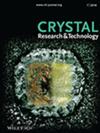Crystallization Behavior and Luminescence of Inkjet Printing CH3NH3PbBr3
IF 1.9
4区 材料科学
Q3 CRYSTALLOGRAPHY
引用次数: 2
Abstract
Lead halide perovskites display remarkable optoelectronic properties, like large absorption coefficients, high photoluminescence quantum efficiencies, and long lifetime and diffusion length of photocarriers. This system is easily fabricated using solution processes and inkjet printing is an effective way to prepare halide perovskite films and complex patterns. In this work, the crystallization behaviors of inkjet printing CH3NH3PbBr3 crystals are systematically investigated with varied I− doping, printing times, and solvents. Using N,N‐dimethylformamide (DMF) solvent, CH3NH3PbBr3−xIx (x = 0, 0.14, 0.29, 0.45, 0.59) are printed on the glass and the crystalline grains are developed from the (001) oriented tetragonal in side length of 10–50 µm to dendrite with increasing I− concentrations. The crystalline grains are kept tetragonal, while the average crystal size changes from 22 to 89 µm by increasing the number of printing from 10 to 1000 times. DMF and dimethyl sulfoxide (DMSO) are used as solvents for printing CH3NH3PbBr3, and more regular grains are obtained from DMF solvent. Several patterns are printed on glass and papers, and fluorescent two‐dimensional (2D) patterns are observed under the 480 nm excitation. The as‐printed patterns show excellent homogeneity and high reproducibility, indicating that the inkjet printing shows broad application prospects in flexible electronics.喷墨打印CH3NH3PbBr3的结晶行为和发光性能
卤化铅钙钛矿具有吸收系数大、光致发光量子效率高、光载流子寿命长、扩散长度长等显著的光电性能。该体系易于采用溶液工艺制备,喷墨打印是制备卤化物钙钛矿薄膜和复杂图案的有效方法。本文系统地研究了不同I−掺杂、印刷时间和溶剂对CH3NH3PbBr3喷墨打印结晶行为的影响。利用N,N‐二甲基甲酰胺(DMF)溶剂,将CH3NH3PbBr3−xIx (x = 0,0.14, 0.29, 0.45, 0.59)印刷在玻璃上,随着I−浓度的增加,晶粒从边长为10-50µm的(001)取向四方向枝晶发育。当打印次数从10次增加到1000次时,晶粒保持四边形,而平均晶粒尺寸从22µm变化到89µm。采用DMF和二甲基亚砜(DMSO)作为溶剂印刷CH3NH3PbBr3, DMF溶剂可以得到更规则的颗粒。在玻璃和纸张上印刷了几种图案,并在480 nm激发下观察到荧光二维(2D)图案。结果表明,喷墨打印技术在柔性电子领域具有广阔的应用前景。
本文章由计算机程序翻译,如有差异,请以英文原文为准。
求助全文
约1分钟内获得全文
求助全文
来源期刊
自引率
6.70%
发文量
121
审稿时长
1.9 months
期刊介绍:
The journal Crystal Research and Technology is a pure online Journal (since 2012).
Crystal Research and Technology is an international journal examining all aspects of research within experimental, industrial, and theoretical crystallography. The journal covers the relevant aspects of
-crystal growth techniques and phenomena (including bulk growth, thin films)
-modern crystalline materials (e.g. smart materials, nanocrystals, quasicrystals, liquid crystals)
-industrial crystallisation
-application of crystals in materials science, electronics, data storage, and optics
-experimental, simulation and theoretical studies of the structural properties of crystals
-crystallographic computing

 求助内容:
求助内容: 应助结果提醒方式:
应助结果提醒方式:


